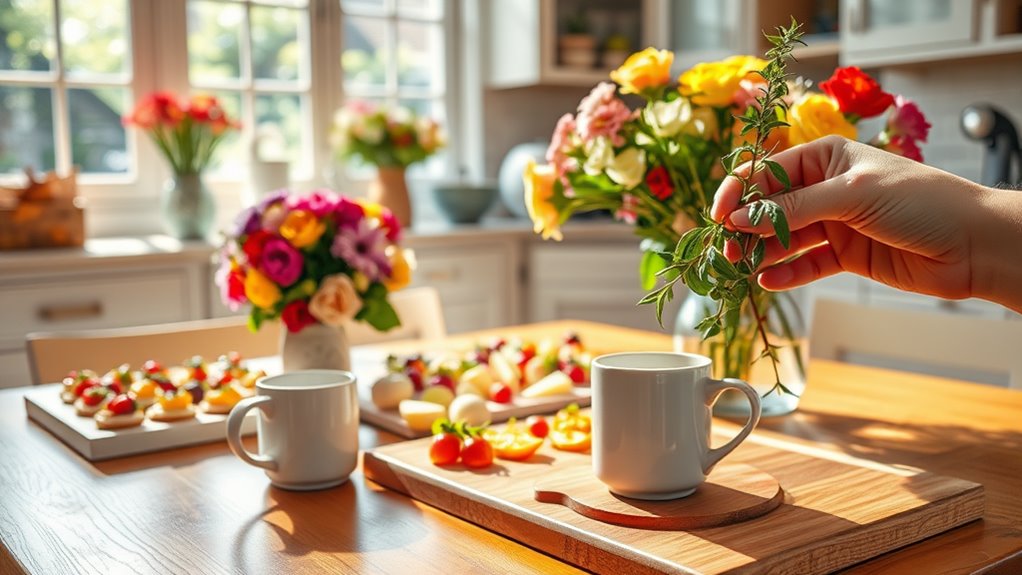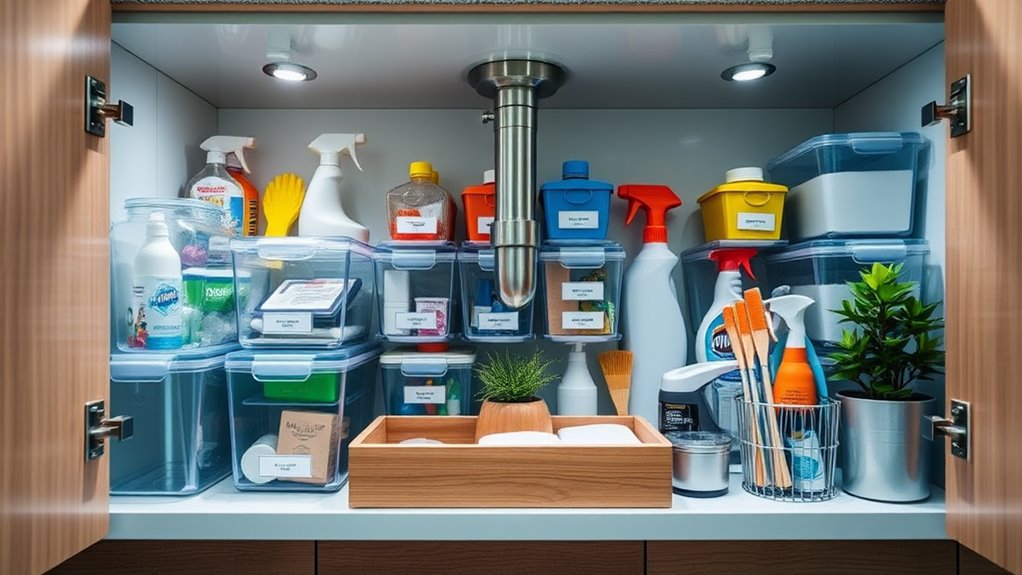3 Must-Know Tips for Keeping Countertops Germ-Free Naturally
To keep your countertops germ-free naturally, start by creating your own cleaning solution using equal parts white vinegar and water, adding essential oils if you like. Master proper disinfecting techniques by applying your cleaner and letting it sit for at least 10 minutes. Finally, establish daily maintenance routines by wiping down surfaces with a microfiber cloth. These simple practices can make a big difference in your kitchen’s cleanliness, and there’s even more to discover about effective cleaning strategies.
Key Takeaways
- Mix equal parts white vinegar and water in a spray bottle for an effective natural disinfectant.
- Allow the disinfectant to sit on surfaces for at least 10 minutes to maximize germ-fighting capabilities.
- Use a clean cloth or paper towel to wipe surfaces, preventing cross-contamination.
- Implement daily maintenance by wiping down countertops with a natural cleaner to reduce germ buildup.
- Declutter surfaces regularly to minimize hiding spots for germs and promote easier cleaning.
Create Your Own Natural Cleaning Solution
Creating your own natural cleaning solution is easier than you might think. To master the art of countertop cleaning, start with simple ingredients.
Mix equal parts white vinegar and water in a spray bottle, adding a few drops of essential oil for fragrance and additional antibacterial properties. This solution effectively cuts through grime while being safe for your surfaces. Natural cleaning solutions also help reduce the use of harsh chemicals in your home. In fact, many homemade cleaners can provide a more eco-friendly option compared to commercial products. Using steam cleaning can further enhance your sanitization efforts, as it effectively eliminates bacteria without any chemicals. Additionally, hydrogen peroxide can be a powerful ally in your cleaning arsenal, as it is known for its disinfectant properties.
When using your homemade cleaner, apply it generously and let it sit for a minute to maximize its germ-fighting capabilities. For stubborn stains, sprinkle baking soda on the countertop before spraying your solution.
This combination offers a powerful, natural way to maintain cleanliness. Additionally, using an eco-friendly all-purpose cleaner can help preserve the shine on various kitchen appliances. By following these countertop tips, you’ll achieve a germ-free surface while embracing eco-friendly practices.
Master the Art of Disinfecting Techniques
While you may already have a cleaning routine, mastering proper disinfecting techniques is essential for truly germ-free countertops.
To elevate your skills, follow these key steps:
-
Choose the Right Disinfectant****: Opt for a natural solution like vinegar or hydrogen peroxide. Make certain it’s effective against bacteria and viruses, as eco-friendly solutions can be just as effective as harsh chemicals. Additionally, many natural disinfectants have environmental benefits that contribute to a healthier home, making them a preferred choice for household safety. Using an eco-friendly all-purpose cleaner can simplify your cleaning process while ensuring safety for your family.
-
Apply Correctly: Spray your disinfectant evenly across the surface. Allow it to sit for at least 10 minutes to guarantee maximum efficacy.
-
Wipe with Precision: Use a clean cloth or paper towel to wipe the surface. This removes germs while preventing cross-contamination.
Additionally, be aware that some commercial cleaning products can damage countertop surfaces, so it’s best to stick with natural alternatives.
Establish Daily Maintenance Routines
To keep your countertops germ-free, establishing a daily maintenance routine is essential. Start by wiping down your surfaces with a natural cleaner every day. Use a microfiber cloth to trap dust and bacteria effectively. Additionally, don’t forget to declutter; a tidy space minimizes the risk of germ accumulation. Implementing a strategic 15-minute daily cleaning routine can further enhance your efforts in maintaining cleanliness. Regular maintenance not only prevents buildup but also promotes a consistently presentable home. Incorporating a balanced cleaning schedule can also help in managing tasks without overwhelming yourself. Additionally, utilizing high-impact tasks can significantly reduce the time spent on cleaning.
One effective method to streamline your cleaning process is to identify smart shortcuts that can help you save time.
Here’s a simple routine to follow:
| Time of Day | Task |
|---|---|
| Morning | Wipe down with natural cleaner |
| Afternoon | Declutter and organize |
| Evening | Inspect for spills and crumbs |
| Weekly | Deep clean with vinegar solution |
Frequently Asked Questions
What Materials Are Best for Germ-Free Countertops?
When choosing materials for germ-free countertops, opt for non-porous options like quartz, stainless steel, or glass. These surfaces resist bacteria and stains, making them easier to clean and maintain, ensuring your kitchen stays hygienic.
Can Essential Oils Enhance Natural Cleaning Effectiveness?
Yes, essential oils can definitely enhance natural cleaning effectiveness. Their antimicrobial properties boost your cleaning routine, making it more powerful. Just add a few drops to your favorite cleaner, and you’ll notice improved results.
How Often Should I Deep Clean My Countertops?
You should deep clean your countertops at least once a week, especially after cooking. Regular maintenance prevents buildup, ensuring your surfaces stay hygienic and looking their best. Don’t overlook daily wipes for ongoing cleanliness.
Are There Specific Foods That Attract More Germs?
Certain foods like raw meat, dairy, and fruits can attract more germs due to moisture and bacteria. You should handle these items carefully and clean surfaces immediately after contact to minimize contamination and keep your kitchen safe.
How Do I Prevent Cross-Contamination While Cooking?
To prevent cross-contamination while cooking, you should use separate cutting boards for meats and vegetables, wash your hands frequently, and keep utensils clean. These practices guarantee your meals remain safe and reduce the risk of foodborne illnesses.



